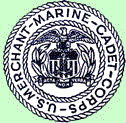The United States Merchant Marine At War:
Report of the War Shipping Administrator to the President
Washington, January 15, 1946 (Excerpt)A New Generation of Seamen
Despite the retention of many active merchant seamen and officers and the recruitment back to sea of previously experienced men, many more were needed to man the thousands of new ships.
Fortunately, as part of the United States Maritime Commission's responsibility under the Merchant Marine Act of 1936, there had been in effect since 1938 a training program for officers and seamen. Shortly after the war began, it was transferred to the WSA and expanded to meet the demand for new men.
The WSA's Training Organization filled this need. In so doing, it gave thousands of young men from every State in the Union and from all walks of life a chance to continue in the profession during peacetime. Today, because of the training program, there is a body of experienced seamen and officers available to meet all demands of the postwar Merchant Marine.
The program was carried on by three units under the Training Organization: The United States Merchant Marine Cadet Corps, the United States Maritime Service, and State Maritime Academies under Federal supervision.
The Cadet Corps provides merchant-officer training in deck and engine departments for young unmarried men with high-school or college education. Entry into the Corps is conditional upon meeting qualifications as midshipmen in the Merchant Marine Naval Reserve. Principal institution of the Corps is the United States Merchant Marine Academy at Kings Point, N. Y., established in January 1941.
This is a permanent facility bearing the same relationship to the Merchant Marine as West Point does to the Army and Annapolis to the Navy. Two basic schools, at Pass Christian, Miss., and San Mateo, Calif., provide preliminary training. All cadet-midshipmen must serve an intermediate period at sea aboard merchant vessels. During the war, 123 were reported dead and missing, and many displayed conspicuous bravery under combat conditions. Although geared during the war to as fast a program as possible to fill the need for trained officers, the course at the Academy will return to a 4-year basis.
There are at present five State Maritime Academies which come under Federal supervision.... They are located in California, Maine, Massachusetts, New York, and Pennsylvania. Requirements for admission are essentially the same as for the United States Merchant Marine Cadet Corps.
From 1938 to December 1, 1945, the combined training programs of the War Shipping Administration have graduated and made available to the Merchant Marine 31,986 deck and engine officers:
